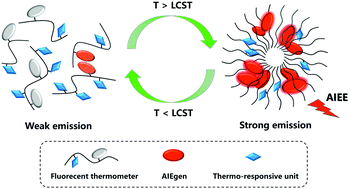Fluorescent thermometer based on a quinolinemalononitrile copolymer with aggregation-induced emission characteristics†
Abstract
Fluorescent molecular thermometers are of great importance because of their potential biomedical applications. However, conventional fluorescent thermometers always face the serious problem of thermal-induced fluorescence quenching. Given that the fluorescence behavior of aggregation-induced emission luminogen (AIEgen)-containing polymers still needs improvement, here we report an AIEgen-grafted copolymer P(NIPAM-co-EM) with a thermo-responsive polymer poly(N-isopropyl acrylamide) (PNIPAM) as a matrix for constructing an AIE fluorescent thermometer. Considering the thermal and fluorescence behaviors, the aqueous copolymer exhibits a specific lower critical solution temperature (LCST) at about 30 °C, along with a fluorescence enhancement of 3.1-fold during the phase transition from 30 to 45 °C. Significantly, the temperature-dependent photophysical characteristic reveals that the fluorescence signal of P(NIPAM-co-EM) can be switched reversibly, thereby achieving the nondestructive sensing of temperature. The resulting copolymer P(NIPAM-co-EM) shows an interesting aggregation-induced enhanced emission (AIEE) activity, which is attributed to the grafted AIE-active unit of quinolinemalononitrile tangled with polymer chains. As demonstrated, the AIEgen-grafted copolymer can be potentially developed as a fluorescent thermometer through its AIEE mechanism.

- This article is part of the themed collections: Recent Progress on Aggregation-Induced Emission and 2019 Materials Chemistry Frontiers HOT articles


 Please wait while we load your content...
Please wait while we load your content...